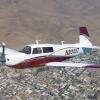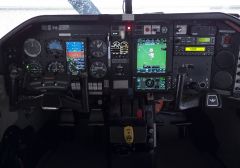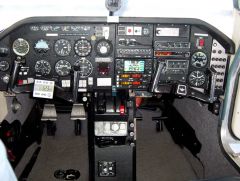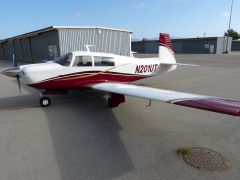-
Posts
63 -
Joined
-
Last visited
-
Days Won
1
Content Type
Profiles
Forums
Blogs
Gallery
Downloads
Media Demo
Events
Everything posted by pfactor
-
Good idea. I'll do that. The last time I tried to climb high in my 201, it was a pretty hot summer day and she pretty much was done climbing at 16,500. I don't plan to see if I can actually get to the flight levels, but maybe I'll record my time to climb to 15,500 That article was great! Thanks for linking that. I didn't know that Power Flow's "travelling machine" is a 1977 201. That's exactly what I've got. I pre-ordered the exhaust so it's waiting at Top Gun for the install at annual. Preordering saved me some money. $4390 for the 201 kit with the ceramic finish. Phil
-
I don't have a good objective way to do this. Phil
-
I'm planning to use video to measure the takeoff distance. I can mount a GoPro under the wing which gives a good view of when the wheels actually break ground. Counting runway stripes should give a pretty accurate distance measure. I just started using CloudAhoy, and I'll see how its calculated takeoff distance compares to what I see on the video. I upload the GPS data from my Garmin 796 to CloudAhoy, which will give me WAAS accuracy. I'll also have a camera pointed at the instrument panel so I can review things like pitch angles and speeds after the flight.
-
I'm going to have a PowerFlow installed in my '77 J model when it goes in for annual later this month. I want to do some before & after testing to actually measure the benefits I see. Power Flow claims it will do these things for a J model: 5 -7 knots faster cruise speeds 10% – 15% increase in rate of climb 0.5 – 1.5 gph reduction in fuel burn at equivalent airspeed Improved Take-Off Performance (100’ – 300’ reduction in ground roll) Increase in Service Ceiling of 2,000’ – 5,000’ Cooler CHT’s Here's what I'm planning to measure in my tests. Short-field ground roll and climb performance at Vx Normal takeoff ground roll and climb performance at Vy Cruise performance at 2500, 7500, and 11,500 MSL (replicate these performance tests) Find service ceiling (can maintain at least 100 fpm climb) I'm open to suggestions for other things I should test. I plan to do the "before" testing next weekend. Phil
-
Top Gun replaced the voltage regulator, and things are much better. I did see one brief flash of the low voltage light on the flight home. We'll try replacing the field wire at annual next month. I'm going to attach two files showing volts & amps. The first is from my flight to SCK with the old voltage regulator. The voltage is inconsistent, but generally above 13.5V. For the flight home, it was rock solid at 13.8V, with just two brief dips down to ~12.5V. Thanks for all the helpful replies! Phil
-
Thanks for the suggestions! It sounds like the next place to focus is the field wire or the alt field circuit breaker. I'll talk to Top Gun about doing that next, maybe just replacing the field circuit breaker as a fairly cheap thing to try. The alternator belt is tight, so I don't think it's that. I believe Top Gun checked the alternator brushes, but I'll make sure to ask about that.
-
No.
-
I'm a displaced Jersey boy.
-
I have a 1977 M20J. For the last month or so, my low voltage light would blink just for 2-3 seconds and then it fixes itself and it's fine. This use to happen maybe once or twice in a 1-hour flgiht. It never lasted long enough for me to really worry about it. When I went in to Top Gun for a 100-hour inspection and I mentioned this issue to them. They suspected a bad electrical connection somewhere, so they checked and cleaned up a bunch of contacts. In the logbook entry they noted that they 1) cleaned the engine-to-airframe ground, 2) repaired the alternator ground and 3) relocated the CGR-30P ground. Unfortunately that didn't fix things. The problem was still happening intermittently. We decided to watch it for a bit to see what happened. Last week, it got worse. I went up for a flight and about 10 minutes after takeoff, the low voltage started blinking and stayed blinking for a few minutes. Per the POH, I tried pulling and then resetting the ALT Field breaker. That didn't make any change. The voltage was below 12V long enough that my Aspen PFD switched itself over to battery backup power. I came in for a landing, and on short final the low voltage light turned off, and the voltage was closer to normal (around 13.5V). It was even fine while taxiing back to parking. I took the plane back to Top Gun last week. On the flight there, I saw a few quick blinks of the low voltage light, but nothing significant. They checked and cleaned all my major electrical connections and ground, tested the battery, the voltage regulator and alternator appeared to be working ok for them. They improved the ground connection for the voltage regulator. My Concorde sealed battery is strong, measuring 12.8V at the terminals. They did swap out my master switch (I think it was the original 1977 one), because there was about 50 ohms resistance present when the switch was on. In short -- no smoking gun found. On the flight home, I unfortunately had a few more blinks of the voltage light. I'm going to call Top Gun tomorrow and figure out what to try next. I wanted to seek out advice from this group. Looking at the engine monitor data, it seems like the voltage is all over the place, which makes me suspect the voltage regulator, but I'm no A&P. I have attached graphs of the low voltage from the engine monitor data. 1) 2015-08-30.png is the flight where the low voltage light first blinked for a few minutes 2) 2015-09-03 RHV-SCK.png is the flight to Top Gun where I had a couple of blinks of low voltage. 3) 2015-09-03 SCK-RHV.png is the flight home, where again I had a few low voltage blinks. 4) 2015-09-05.png is local flight where the voltage was very erratic. Phil
-
Thanks! I used the GoPro adhesive mounts. Phil
-
I made this video of a beautiful sunset flight. https://youtu.be/eSmJb2VQTWI Phil
-

ADS-B and Engine Monitor Upgrade
pfactor replied to GeorgePerry's topic in Avionics/Panel Discussion
I think Mooneymite's question is valid. "Why install an AOA in a Mooney?" My reasons are very similar to Don's (I'm Phil Verghese -- who he referenced in his post). My initial interest was to help me fly the right speed for the current weight. In my M20J, there's about a 10 knot difference between the right speed at max gross, to being lightly loaded. Excess speed means more time floating down the runway. My home runway is about 3,000 feet, which is by no means a short field but I was consistently using more runway than I wanted to because I was flying too fast on final. What really happened was I flew at the max gross Vref, despite knowing that I should have been flying slower when lighter. I just didn't do the math every time and probably could have just made myself a handy table on my checklist. But like Mooneymite and Don, I flew my Mooney without an AOA for over 15 years with no problems. After installing the AOA, I discovered the added benefits of having useful indications for being at Vx, Vy, and Vglide adjusted for weight. In summary, I'm not too worried about getting to slow and making the classic base-to-final stall/spin error. I'm more interested in flying slow enough to minimize my float on landing. I'm consistently using less runway after having the AOA installed. I'm sure I could have done the same without an AOA by being more diligent about calculating my weight and Vref every time. Having the indicator just makes it a no-brainer. Do you need an AOA? No. Will it help you make more consistently good landings? I think so. Phil -
I just posted the pictures from the December WestTex formation clinic. Unfortunately I couldn't make it to this one, but it looks like they had a great time there. Elton did a great job organizing the clinic. Phil
-
For my plane (start of this thread), Executive Autopilots in Sacramento, CA did most of my panel. Top Gun Aviation in Stockton, CA did the AOA indicator and CGR-30P (the latter during my most recent annual, which saved a bit of labor time). Phil
-
I beat the system by marrying a pilot
-
Exactly! I briefly considered "upgrading" to a newer airplane, but then came to my senses.
-
Sound financial planning is when your check to the undertaker bounces.
-
Good to know I'm not the only one suffering from an aviation addiction. Great panels Bob & Marauder!
-
Over the last few years I've upgraded the aging avionics in my 1977 J model. I wish I had a picture of the original 1977 panel before we added the JPI engine monitor and the intercom system. This is as close as I have to a "before" picture Here's what it looks like now Here's what's been installed: - Aspen Evolution 1000 Pro PFD - STEC-30 autopilot - CGR-30P engine monitor / primary gauge replacement - Garmin GTN 750 & 650 - Garmin GDL-88 - PS Engineering PMA450 audio panel - Garmin GTX 327 transponder - Alpha Systems AOA - Eagle display Removed: - ADF - Ailing King KT-76 transponder - Original tachometer, FF/MP gauges, CHT gauge, oil temp gauge, oil pressure gauge It makes zero financial sense to do this, but I'm keeping this plane forever. The CGR-30P is the newest addition and it's been fantastic. It took a few flights to stop looking over at the now blank spot on the right side of the panel for MP & RPM. Phil
-
From the album: Panel evolution
Added a CGR-30P engine monitor / primary instrument replacement, PMA450 intercom and a Garmin GTN 750 and 650. The old NDB finally had to go. -
I don't have a picture of the original panel of our 1977 J model, but this is the path it took over the course of a few years.
-
From the album: Panel evolution
Added an Aspen PFD and an STEC-30 autopilot. -
From the album: Panel evolution
-
I hope you can join us in 2015. It's a ton of fun, and a great challenge. Phil












